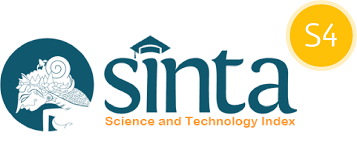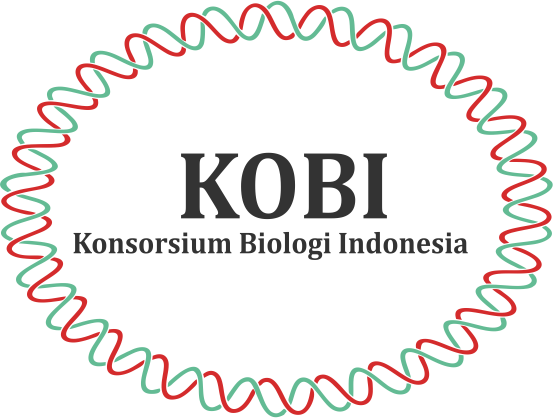Optimasi Waktu Inkubasi dan pH Ganoderma sp. dari Kebun Raya Baturraden untuk Dekolorisasi RBBR
Abstract
Jamur pelapuk putih diketahui memiliki kemampuan untuk mendekolorisasi pewarna, salah satunya jamur Ganoderma sp. dari Kebun Raya Baturraden. Jamur tersebut mampu mendekolorisasi Remazol Brillliant Blue R (RBBR) yang bersifat toksik, mutagenik, karsinogenik, dan stabil terhadap perlakuan fisika maupun kimia. Proses dekolorisasi dapat dipengaruhi oleh faktor lingkungan seperti waktu inkubasi dan pH. Setiap jamur pelapuk putih memiliki waktu inkubasi dan pH optimum yang berbeda dalam mendekolorisasi pewarna. Penelitian ini bertujuan untuk mengetahui kemampuan isolat Ganoderma sp. dari Kebun Raya Baturraden dengan waktu inkubasi dan pH berbeda dalam mendekolorisasi pewarna RBBR, serta mengetahui variasi waktu inkubasi dan pH yang menunjukkan hasil terbaik. Penelitian ini menggunakan metode eksperimental dengan Rancangan Acak Lengkap (RAL) dengan Perlakuan variasi pada penelitian ini terdiri dari waktu inkubasi yaitu 24, 48, 72, 96, dan 120 jam, serta pH 3, 4, 5, 6, dan 7. Hasil penelitian menunjukkan bahwa Ganoderma sp. dari Kebun Raya Baturraden mampu mendekolorisasi RBBR pada waktu inkubasi dan pH berbeda dengan persentase dekolorisasi 4,10% - 83,04%. Persentase dekolorisasi tertinggi ditunjukkan pada waktu inkubasi 96 jam dan pH 6, yaitu 83,04%. Hal tersebut membuktikan bahwa Ganoderma sp. dari Kebun Raya Baturraden memiliki waktu inkubasi optimum 96 jam, serta pH optimum 6 untuk mendekolorisasi RBBR.
References
Adebayo-Tayo, B., Olaseinde, K., Odeniyi, O.A., Wakil, S.M. & Onilude, A., 2016. Catalytic Activity and Purification of Thermostable Lignases from Ganoderma sp. ADE468 and Its Potential Application in The Decolourization of Dyes. Suranaree Journal of Science and Technology, 23(3):309-323.
Agrawal, N., Verma, P. & Shahi, S.K., 2018.Degradation of Polycyclic Aromatic Hydrocarbon (Phenanthrene and Pyrene) by The Ligninolytic Fungi Ganoderma lucidum Isolated from The Hardwood Stump. Bioresources and Bioprocessing, 5(11): 1-9.
Aksu, Z., Tatli, A. & Tunç, O., 2008. A Comparative Adsorption/Biosorption Study of Acid Blue 161: Effect of Temperature on Equilibrium and Kinetic Parameters. Chemical Engineering Journal, 142:23-39.
Almaguer, M., Rojas-Flores, T., Rodríguez-Rajo, J. & Aira, M.J., 2014. Airborne Basidiospores of Coprinus and Ganoderma in a Caribbean Region. Aerobiologia, 30:197–204.
Bilal, M., Asgher, M. & Ramzan, M., 2015. Purification and Biochemical Characterization of Extracellular Manganese Peroxidase from Ganoderma lucidum IBL-05 and Its Application. Academic Journal, 10(14):1-9
Cardoso, N.F., Lima, E.C., Royer, B.M., Bach, V., Dotto, G.L., Pinto, L.A. & Calvete, T., 2012.Comparison of Spirulina platensis Microalgae and Commercial Activated Carbon as Adsorbents for The Removal of Reactive Red 120 Dye from Aqueous Effluents. Jornal of Hazardous Materials, 241-242:146-153.
Chen, S.H. & Ting, A.S.Y., 2015. Biodecolorization and Biodegradation Potential of Recalcitrant Triphenylmethane Dyes by Coriolopsis sp. Isolated from Compost. Journal of Environmental Management, 150:274-280.
Dewi, R.S. & Lestari, S., 2010. Dekolorisasi Limbah Batik Tulis Menggunakan Jamur Indigenous Hasil Isolasi pada Konsentrasi Limbah yang Berbeda. Molekul, 5(2):75-82.
Dewi, R.S., Kasiamdari, R.S., Martani, E. and Purwestri, Y.A., 2019a, April. Optimization of the conditions for the decolorization of batik wastewater by Aspergillus sp. 3. In AIP Conference Proceedings (Vol. 2094, No. 1, p. 020036). AIP Publishing LLC.
Dewi, R.S., Ilyas, M. and Sari, A.A., 2019b. Ligninolitic Enzyme Immobilization from Pleurotus ostreatus for Dye and Batik Wastewater Decolorization. Jurnal Pendidikan IPA Indonesia, 8(2),:220-229.
El-Rahim, W.M.A., El-Ardy, O.A.M. & Mohammad, F.H.A., 2009. The Effect of pH on Bioremediation Potential for The Removal of Direct Violet Textile Dye by Aspergillus niger. Desalination, 249(3):1206-1211.
Fouillaud, M., Caro, Y., Venkatachalam, M., Grondin, I. & Dufossé, L., 2017. Anthraquinones. England: Taylor and Francis Group.
Fu, Y. & Viraraghavan, T., 2001. Fungal Decolorization of Dye Wastewaters: A Review. Bioresource Technology, 79:251-262.
Gandjar, I., Sjamsuridzal, W. & Oetari, A., 2007. Mikologi Dasar dan Terapan. Jakarta: Yayasan Buku Obor.
Hadibarata, T. & Kristanti, R.A., 2012. Effect of Environmental Factors in The Decolorization of Remazol Brilliant Blue R by Polyporus sp. S133. Journal of The Chilean Chemical Society, 57(2):1095-1098.
Hasanuddin, 2014. Jenis Jamur Kayu Makroskopis Sebagai Media Pembelajaran Biologi (Studi di TNGL Blangjerango Kabupaten Gayo Lues). Jurnal Biotik, 2(1):1-76.
Hidayati, P., Ulfin, I. & Juwono, H., 2016. Adsorpsi Zat Warna Remazol Brilliant Blue R Menggunakan Nata De Coco: Optimasi Dosis Adsorben dan Waktu Kontak. Jurnal Seni dan Sains ITS, 5(2):134-136.
Lazim, Z.M., Mazuin, E., Hadibarata, T. & Yusop, Z., 2015. The Removal of Methylene Blue and Remazol Brilliant Blue R Dyes by Using Orange Peel and Spent Tea Leaves. Journal Teknologi, 74:129-135.
Lu, R., Ma, L., He, F., Yu, D., Fan, R., Zhang, Y., Long, Z., Zhang, X. & Yang, Y., 2015. White-Rot Fungus Ganoderma sp.En3 Had a Strong Ability to Decolorize and Tolerate The Anthraquinone, Indigo and Triphenylmethane Dye with High Concentrations. Bioprocess and Biosystems Engineering, 39(3):381-390.
Ma, L., Zhuo, R., Liu, H., Yu, D., Jiang, M., Zhang, X. & Yang, Y., 2014. Efficient Decolorization and Detoxification of The Sulfonated Azo Dye Reactive Orange 16 and Simulated Textile Wastewater Containing Reactive Orange 16 by The White-Rot Fungus Ganoderma sp. En3 Isolated from The Forest of Tzu-chin Mountain in China. Biochemical Engineering Journal, 82:1-9.
Muslimah, S. & Kuswytasari, N.D., 2013. Potensi Basidiomycetes Koleksi Biologi ITS sebagai Agen Biodekolorisasi Zat Warna RBBR. Jurnal Sains dan Seni Pomits, 2(1):2337-3520.
Nguyen, B.T.T., Ngo, N.X., Le, V.V., Nguyen, L.T., Kana, R. & Nguyen, H.D., 2019. Optimal culture conditions for mycelial growth and fruiting body formation of Ling Zhi mushroom Ganoderma lucidum strain GA3. Vietnam Journal of Science, Technology and Engineering, 61(1):62-67.
Novak, J.T., Robert, C.H. & Clifford, W.R., 2001. Biological Treatment of a Synthetic Dye Water and an Industrial Textile Wastewater Containing Azo Dye Compounds. Blacksburg Viriginia: Virginia Polytechnic Institute and State University.
Noviendri, D., Fawzya, Y.N. & Chasanah, E., 2008. Karakteristik dan Sifat Kinetika Enzim Kitinase dari Isolat Bakteri T5a1 Asal Terasi. Jurnal Pascapanen dan Bioteknologi Kelautan dan Perikanan, 3:123-129.
Oliveira, S.F., Luz, J.M.R., Kasuya, M.C.M., Ladeira, L.O. & Ary Correa Junior., 2018. Enzymatic Extract Containing Lignin Peroxidase Immobilized on Carbon Nanotubes: Potential Biocatalyst in Dye Decolourization. Saudi Journal of Biological Sciences, 25:651-659.
Osma, J.F., Herrera, J.L.T. & Couto, S.R., 2010.Transformation Pathway of Remazol Brilliant Blue R by Immobilised Laccase. Bioresource Technology, 101:8509-8514.
Papadopoulou, K., Kalagona, I.M., Philippoussis, A. & Rigas, F., 2013. Optimization of Fungal Decolorization of Azo and Anthraquinone Dyes iaBox-Behnken Design. International Biodeterioration & Biodegradation, 77:31-38.
Purnama, H. & Setiati., 2004. Adsorbsi Limbah Tekstil Sintesis dengan Jerami Padi. Jurnal Teknik Gelagar, 15(1):1-9.
Rahmat, N.A., Ali, A.A., Salmiati, Hussain, N., Muhamad, M.S., Kristanti, R.A. & Hadibarata, T., 2016. Removal of Remazol Brilliant Blue R from Aqueous Solution by Adsorption Using Pineapple Leaf Powder and Lime Peel Powder. Water, Air and Soil Pollution, 227:105-115.
Rao, M.A., Scelza, R., Acevedo, F., Diez, M.C. & Gianfreda, L., 2014. Enzymes as Useful Tools for Environmental Purposes. Chemosphere, 107:145-162,
Saeed, A., Iqbal, M. & Zafar, S.I., 2009. Immobilization of Trichoderma viride for Enhanced Methylene Blue Biosorption: Batch and Column Studies. Journal of Hazardous Materials, 168:406-415.
Saetang, J. & Babel, S., 2010. Fungi Immobilization for Landfill Leachate Treatment. Water Science and Technology, 62(6):1240-1247
Saito, Y., Tsuchida, H., Matsumoto, T., Makita, Y., Kawashima, M., Kikuchi, J. & Matsui, M., 2018. Screening of Fungi for Decomposition of Lignin-Derived Products from Japanese Cedar. Journal of Bioscience and Bioengineering, 126(5):573-579.
Sari, A.A. & Dewi, R.S., 2019. The Study of Basidiomycota and Glomeromycota Biodiversity in Baturraden Botanical Garden, Indonesia. Report Research. Research Grant Programme, NEF.
Siswanto, S., Suharyanto & Rosy, F., 2007. Produksi dan Karakterisasi Lakase Omphalina sp. Menara Perkebunan, 75(2):106-115.
Sudiana, I.K., Sastrawidana, I.D.K. & Sukarta, I.N., 2018. Decolorization Study of Remazol Black B Textile Dye Using Local Fungi of Ganoderma sp. and Their Ligninolytic Enzymes. Journal of Environmental Science and Technology, 11(1):16-22.
Sumathi, S. & Phatak, V., 1999. Fungal Treatment of Bagasse Based Pulp and Paper Mill Wastes. Environmental Technology, 19:93-98.
Torres-Farradá, G., Manzano-León, A.M., Rineau, F., Leal, M.R., Thijs, S., Jambon, I., Put, J., Czech, J. Rivera, G.G., Carleer, R. & Vangronsveld, J., 2019. Biodegradation of Polycyclic Aromatic Hydrocarbons by Native Ganoderma sp. Strains: Identification of Metabolites and Proposed Degradation Pathways. Applied Microbiology and Biotechnology, 1-13.
Upadhyay, P., Shrivastava, R. & Agrawal, P.K., 2016. Bioprospecting and Biotechnological Applications of Fungal Laccase. 3 Biotech, 6(1):15.
Volesky, B., 1990. Biosorption by Heavy Metals. Florida: CRC Press.
Yesiladal, K.S., Pekin, G.L., Bermek, H., Alaton, I.A., Orhon, D. & Tamerler, C., 2006. Bioremediation of Textile Azo Dyes by Trichophyton rubrum LSK-27. World Journal of Microbiology & Biotechnology, 22:1027-1031.
Zeng, X., Cai, Y., Liao, X., Zeng, X., Li, W. & Zhang, D., 2011. Decolorization of Synthetic Dyes by Crude Laccase from A Newly Isolated Trametes trogii Strain Cultivated on Solid Agro-Industrial Residue. Journal of Hazardous Materials, 187:517-525.
Zhuo, R., Ma, L., Fan, F., Gong, Y., Wan, X., Jiang, M., Zhang, X. & Yang, Y., 2011. Decolorization of Different Dyes by a Newly Isolated White-Rot Fungi Strain Ganoderma sp.En3 and Cloning and Functional Analysis of Its Laccase Gene. Journal of Hazardous Materials,192: 855-873.














_copy.png)



